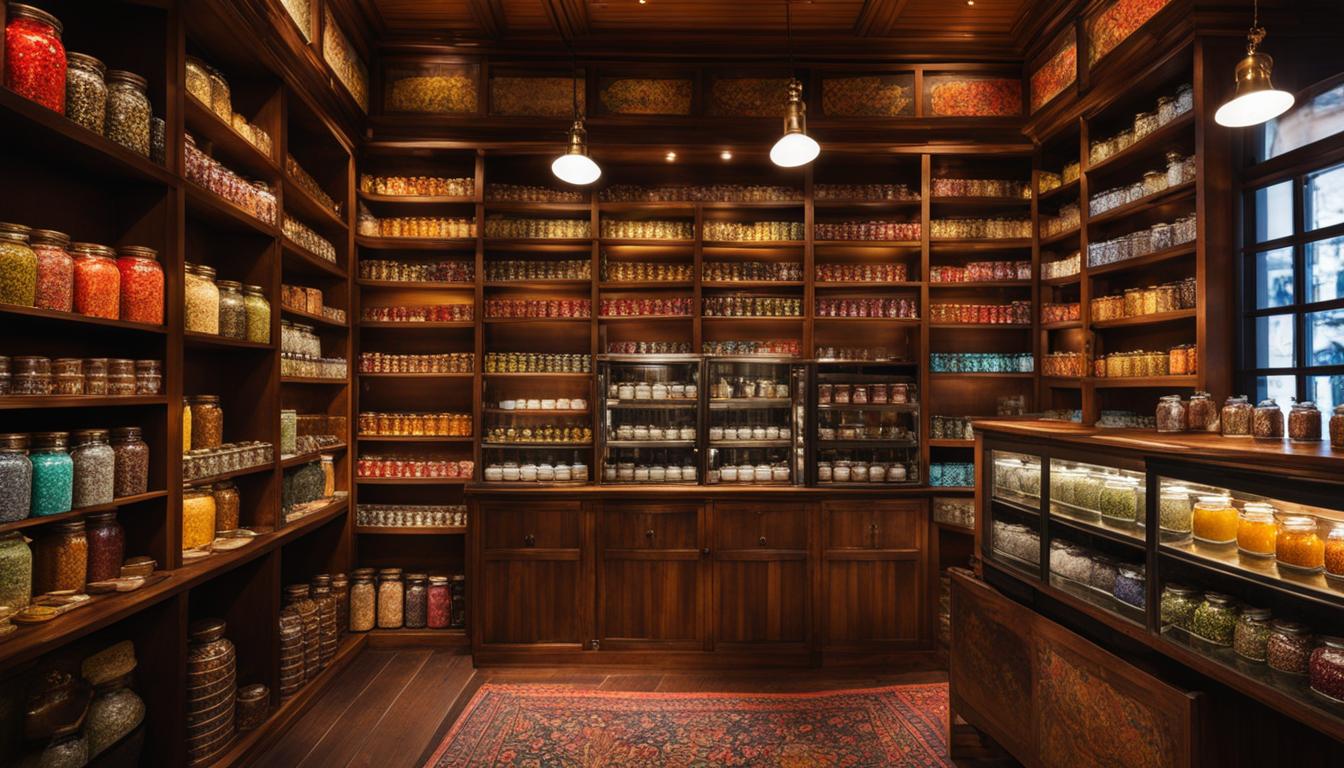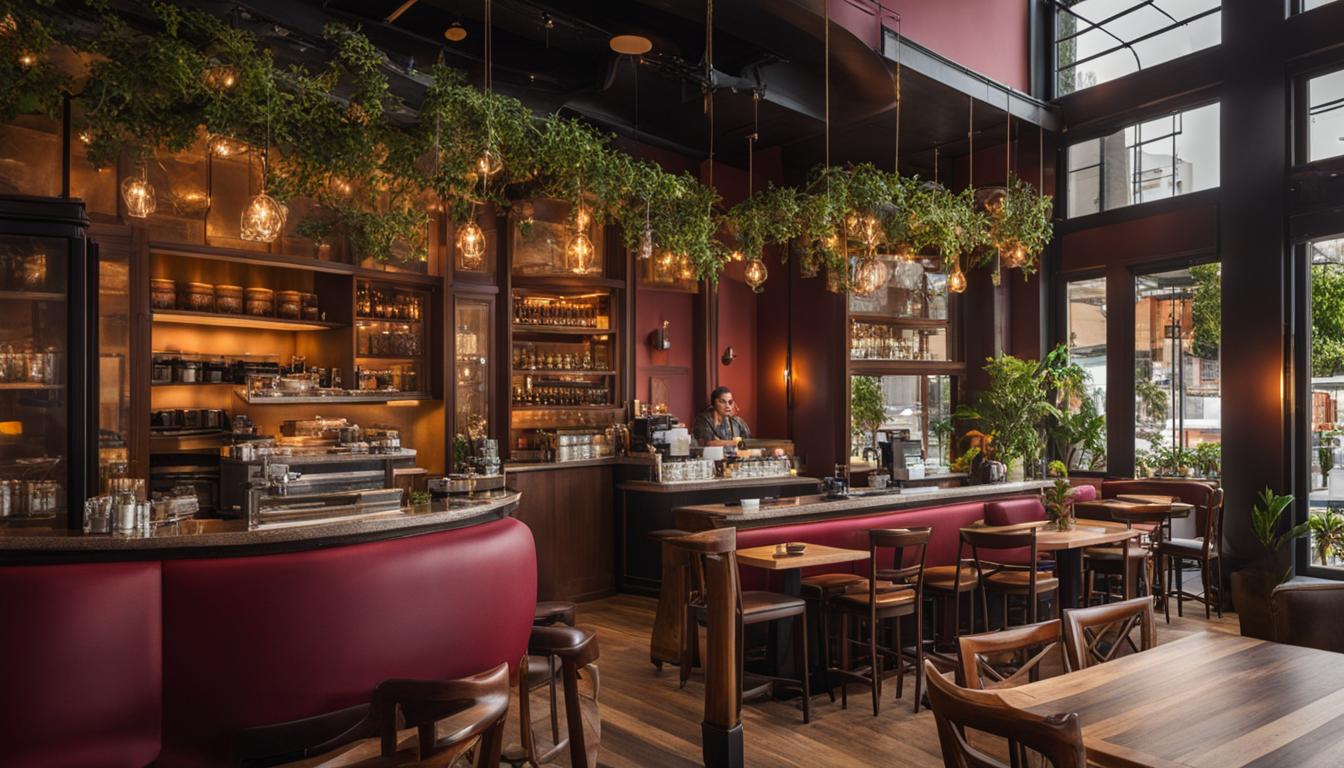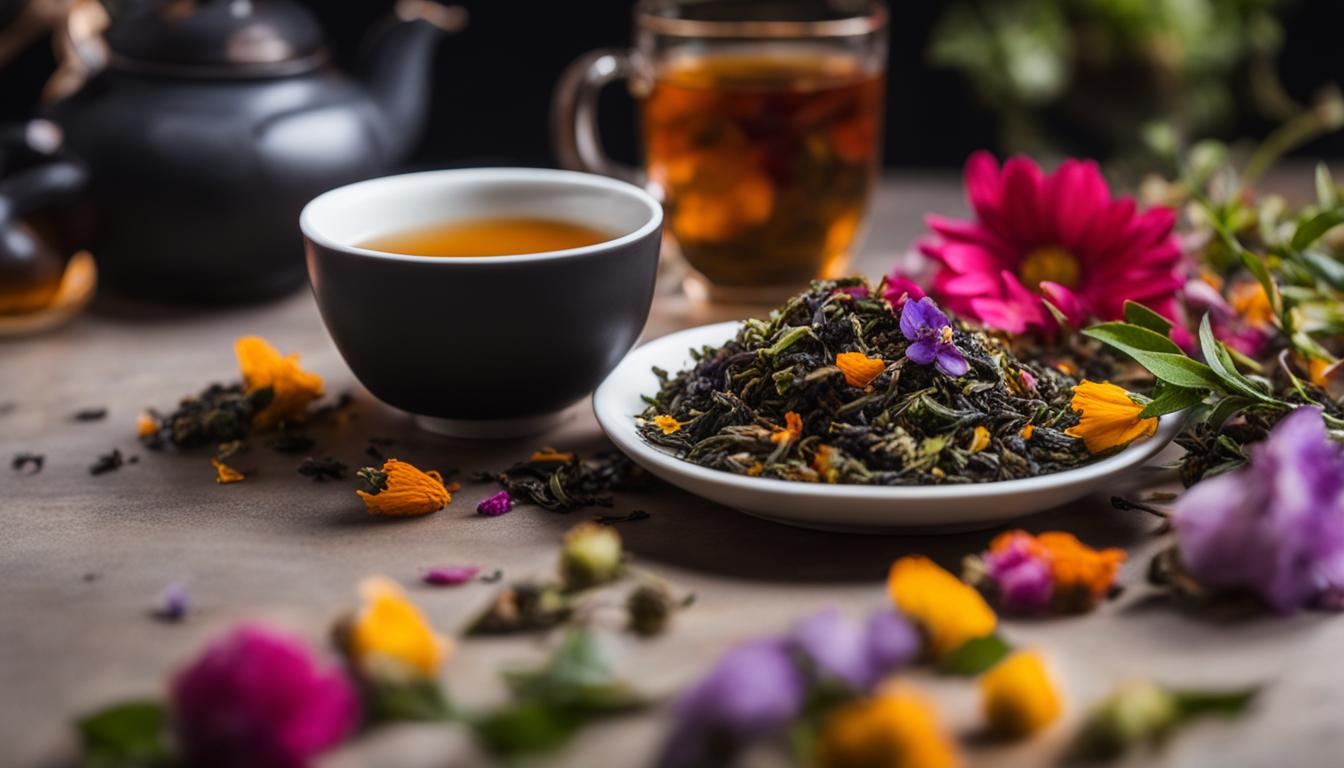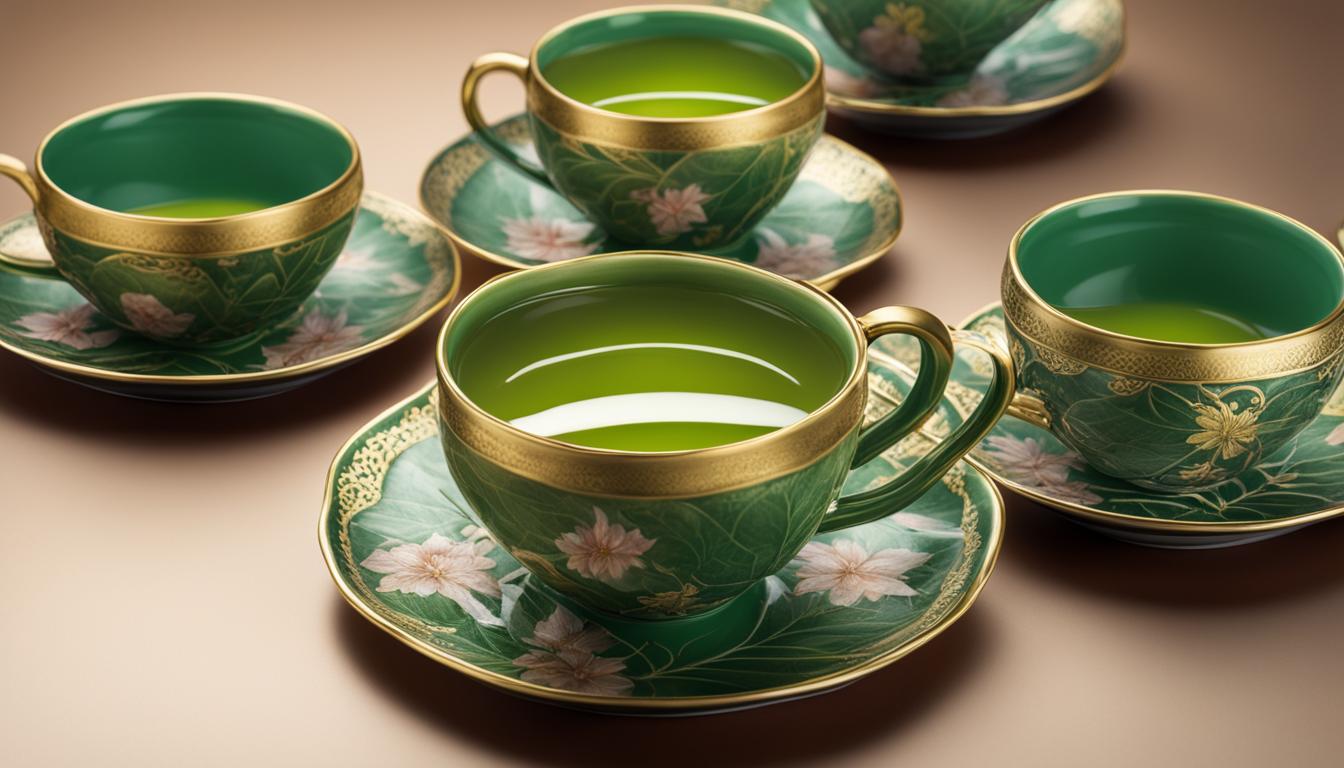Welcome to our comprehensive guide on handcrafted tea varieties! If you’re a tea enthusiast looking to explore the diverse world of artisan loose leaf teas and crafted herbal tea blends, you’ve come to the right place. We’re here to provide you with insights, recommendations, and useful information to enhance your tea-drinking experience.
Handcrafted teas offer a delightful range of flavors and brewing techniques that cater to every palate. From delicate and floral to robust and earthy, each handcrafted tea variety has its own unique characteristics and taste profiles.
In this guide, we’ll be diving into the essence of Japanese tea, exploring the vast array of handcrafted tea varieties available, mastering the art of tea brewing, delving into tea serving etiquette and tea pairing, and much more. So grab your favorite teacup and join us on this aromatic journey into the world of handcrafted teas!
Key Takeaways:
- Handcrafted tea varieties offer a range of flavors and brewing techniques for tea enthusiasts.
- Japanese teas hold a special place in the world of tea, with Matcha and Sencha being notable varieties.
- Understanding the basics of tea brewing, including equipment, temperature, and brewing time, is essential for a perfect cup of tea.
- Tea serving etiquette and tea pairing enhance the overall tea-drinking experience.
- Embracing the art of handcrafted teas enhances appreciation and enjoyment of this timeless beverage.
The Essence of Japanese Tea
Japanese teas hold a special place in the world of tea. From the ceremonial grace of Matcha to the comforting warmth of Sencha, each variety of Japanese tea offers a unique story and sensory experience. Japanese teas are not only known for their quality but also for their health benefits, as they are rich in antioxidants. Additionally, Japanese tea culture plays a significant role in the appreciation and enjoyment of these handcrafted teas.
When it comes to Japanese tea, Matcha is undoubtedly the star of the show. This vibrant green tea is finely ground into a powder and traditionally prepared using a bamboo whisk. The result is a smooth and creamy beverage with a rich umami flavor. Matcha is not only enjoyed on its own but is also used as an ingredient in various culinary creations.
Another popular Japanese tea is Sencha. This traditional green tea is known for its vegetal and slightly grassy taste. The leaves of Sencha are harvested in the early spring, giving it a fresh and invigorating flavor. Sencha is enjoyed daily by many Japanese people and is often served alongside meals or during tea ceremonies.
Serving and drinking Japanese tea is not merely about the beverage itself, but it is an immersive cultural experience. It is a way to connect with tradition, mindfulness, and the beauty of nature. The art of tea has been passed down through generations, and each cup tells a story of Japan’s rich heritage and appreciation for simplicity and harmony – all while enjoying the myriad of flavors Japanese tea has to offer.
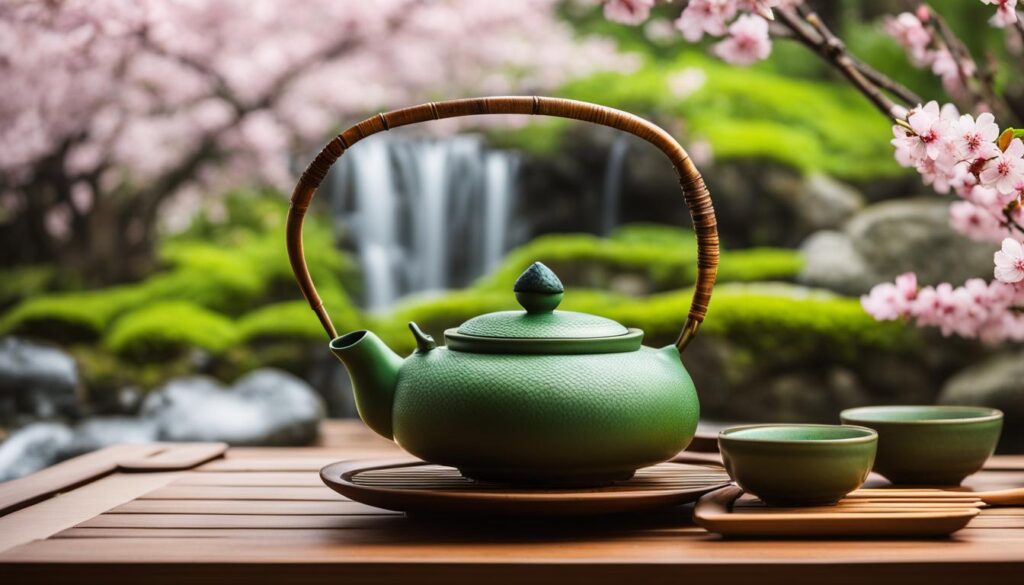
Tea Culture and Health Benefits
Japanese tea culture, also known as “Chanoyu,” is deeply rooted in the country’s history and rituals. The tea ceremony, or “Sado,” is a practice that embodies harmony, respect, and tranquility. It is a mindful and deliberate act of preparing and serving tea, creating a serene environment for both the host and the guest.
In addition to the cultural significance, Japanese teas are also celebrated for their health benefits. The antioxidants found in Japanese green teas, such as Matcha and Sencha, have been associated with numerous health advantages. These include boosting metabolism, improving mental alertness, and even promoting heart health. Regular consumption of Japanese teas can be a delicious way to incorporate wellness into your daily routine.
Explore the World of Japanese Tea
Japanese tea offers a treasure trove of flavors and experiences waiting to be discovered. Whether you prefer the vibrant intensity of Matcha or the refreshing simplicity of Sencha, each cup of Japanese tea invites you to savor the moment and indulge in the rich tapestry of Japanese culture. So why not embrace the essence of Japanese tea and embark on a delightful journey of taste, tradition, and tranquility?
Deep Dive into Japanese Tea Varieties
Japanese tea offers a wide range of flavors and characteristics, each variety providing a unique experience for tea enthusiasts. Let’s explore some of the most popular Japanese tea varieties:
1. Matcha
Known for its vibrant green color and smooth, creamy flavor, Matcha is a ceremonial green tea that has gained popularity worldwide. It is prepared by grinding shade-grown tea leaves into a fine powder, which is then whisked into hot water. Matcha is revered for its energizing properties and high concentration of antioxidants, making it a favorite among health-conscious tea drinkers.
2. Sencha
Sencha is the most commonly consumed green tea in Japan. It is made from steamed tea leaves, resulting in a delicate balance of sweetness and slight bitterness. Sencha has a refreshing taste and can be enjoyed both hot and cold. This versatile tea is perfect for daily consumption and pairs well with a variety of dishes.
3. Genmaicha
Genmaicha is a unique green tea that combines sencha or bancha leaves with roasted brown rice. The roasted rice imparts a nutty and toasty flavor to the tea, creating a comforting and aromatic brew. Genmaicha is often enjoyed with meals and is popular for its ability to aid digestion.
4. Hojicha
Hojicha is a roasted green tea with a distinct smoky aroma and a caramel-like flavor. It is made by roasting sencha or bancha leaves at a high temperature, resulting in a reddish-brown appearance. Hojicha has a mild and soothing taste, making it an ideal choice for those seeking a tea with lower caffeine content.
5. Gyokuro
Gyokuro is a premium shaded green tea with a deep, rich umami flavor. The tea leaves are grown under shade for several weeks before harvest, which enhances their sweetness and decreases bitterness. Gyokuro is considered one of the finest Japanese teas and is often savored during special occasions.
6. Kukicha
Kukicha, also known as “twig tea,” is made from the stems and twigs of the tea plant. It has a mildly nutty flavor and a light, refreshing taste. Kukicha is low in caffeine and can be enjoyed throughout the day. Its unique blend of flavors makes it a popular choice among tea connoisseurs.
7. Sobacha
Sobacha is a roasted buckwheat tea that has a rich, nutty taste. It is caffeine-free and often consumed as a substitute for coffee or traditional teas. Sobacha is known for its comforting aroma and is enjoyed both hot and cold.
8. Kuromamecha
Kuromamecha is a black tea made from black soybeans. It has a sweet and nutty flavor that is reminiscent of roasted chestnuts. Kuromamecha is a unique and lesser-known Japanese tea that offers a delightful taste experience.
9. Bancha
Bancha is a staple green tea in Japanese households. It is made from mature tea leaves and has a robust flavor with lower caffeine content than other green teas. Bancha is often enjoyed after meals and is known for its satisfying and refreshing taste.
10. Konacha
Konacha is a vibrant green tea that is made from the fine particles left over from processing other teas. It has a strong and intense flavor, making it a popular choice for pairing with sushi and sashimi. Konacha adds a burst of freshness to every sip.
Each Japanese tea variety offers a unique taste profile and brewing experience. Whether you prefer the smoothness of Matcha, the refreshing notes of Sencha, or the unique flavors of Genmaicha and Hojicha, exploring Japanese tea varieties is a delightful journey for any tea lover.
Master the Art of Tea Brewing
Tea brewing is an art that has been perfected over centuries, with a rich history and a myriad of health benefits. To brew the perfect cup of tea, it is important to understand the equipment, temperature, brewing time, and water quality that will enhance the flavors and aromas of your chosen tea. So, let’s dive into the fascinating world of tea brewing and unlock the secrets to a truly exquisite tea experience.
Equipment
Having the right tools is essential for a successful tea brewing session. The equipment you’ll need includes a teapot, tea infuser or strainer, kettle, and a timer. Choose a teapot and infuser that are suitable for the type of tea you’re brewing. For example, a teapot with a built-in infuser works well for loose leaf teas, while a gaiwan is perfect for brewing traditional Chinese teas. Invest in a good-quality kettle that allows you to control the water temperature accurately, as different teas require specific temperatures for optimum flavor extraction.
Temperature and Brewing Time
The temperature and brewing time are crucial factors in achieving the perfect cup of tea. Each type of tea has its own ideal brewing temperature and time, which can vary significantly. For example, delicate green teas like Sencha are best brewed at lower temperatures around 160°F (70°C) for 1-2 minutes, while robust black teas like Assam require higher temperatures around 212°F (100°C) for 3-5 minutes. Avoid using boiling water for green and white teas, as it can result in a bitter taste. Experiment with different brewing parameters to find your preferred balance of flavor and strength.
Water Quality
The quality of the water used for brewing tea can greatly impact the taste and aroma. Ideally, use fresh, filtered water that is free from impurities and chlorine, as these can alter the flavors of the tea. Avoid using distilled or overly mineralized water, as they can also affect the taste. If your tap water has a strong odor or taste, consider using a water filter or opt for bottled spring water to ensure the purest tea experience.
| Tea Type | Water Temperature | Brewing Time |
|---|---|---|
| Green Tea | 160-180°F (70-82°C) | 1-3 minutes |
| Black Tea | 200-212°F (93-100°C) | 3-5 minutes |
| Oolong Tea | 180-200°F (82-93°C) | 2-4 minutes |
| White Tea | 170-190°F (77-88°C) | 1-3 minutes |
Remember, tea brewing is not just a science, but also an art that allows you to express your preferences and create a truly personalized cup of tea. Experiment with different brewing techniques, temperatures, and brewing times to discover your perfect brew. With each sip, you’ll embark on a sensory journey that transcends time and connects you with the rich history and culture of tea.
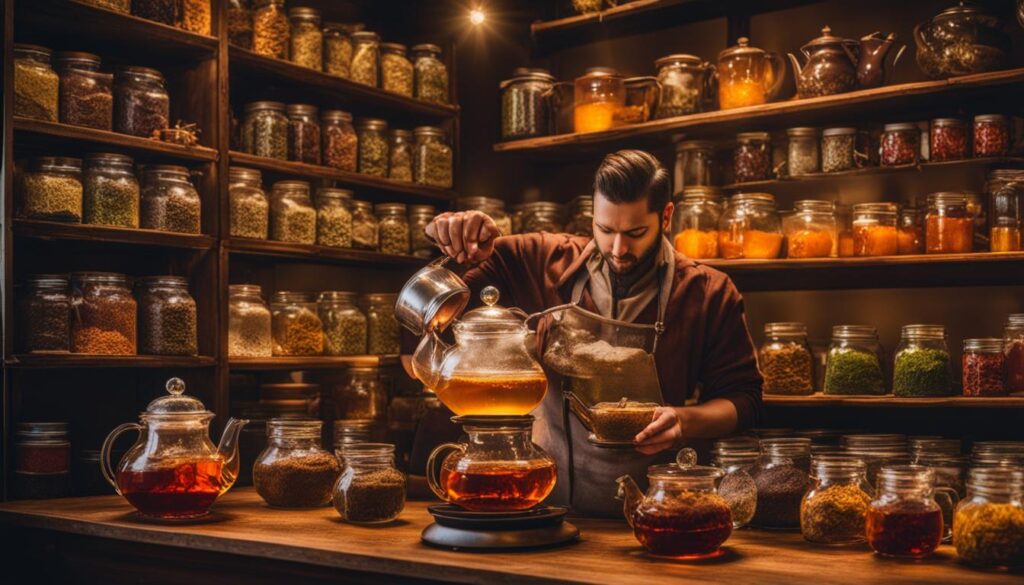
Tea Serving Etiquette and Tea Pairing
Tea serving etiquette and tea pairing are integral parts of the tea-drinking experience. It is not just about the beverage itself but also about the rituals and traditions that accompany it. Different cultures have their own customs and traditions when it comes to serving tea, each adding its unique charm to the experience. Let’s explore some of these fascinating practices and discover the art of tea serving etiquette.
Formal Tea Service
In formal tea service, elegance and precision take center stage. This refined practice is often associated with Japanese tea ceremonies and British high tea. In a formal tea setting, the focus is on creating a serene and harmonious atmosphere. The host prepares and serves the tea with meticulous attention to detail, following specific rituals and gestures. Guests are expected to observe proper etiquette, showing respect for the tea, the host, and fellow participants.
In a formal tea service, the host performs a choreographed sequence of movements, pouring just the right amount of tea into each cup. The cups are then presented to the guests, who receive them with a bow of gratitude. Each sip is savored slowly and silently, appreciating the flavors and the moment.
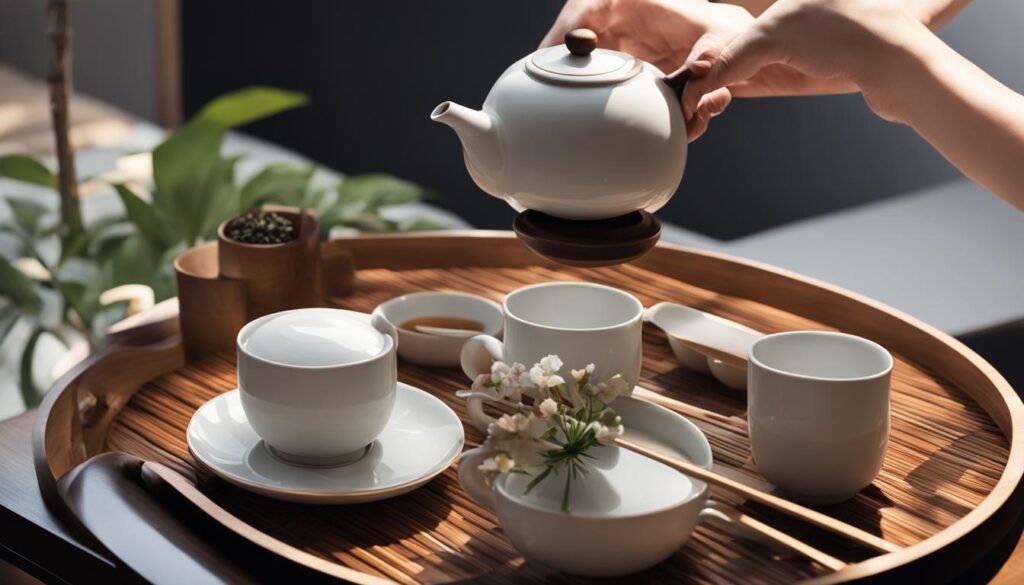
Casual Tea Service
In contrast to formal tea service, casual tea service offers a more relaxed and informal experience. It is often seen in social gatherings or as a daily ritual in many households. In casual tea service, the emphasis is on comfort, warmth, and connection. Friends and family come together to enjoy a cup of tea in a laid-back setting, where conversation and laughter flow freely.
Casual tea service allows for flexibility and personal preferences. Guests can choose their preferred tea and enjoy it as they please. It is a time for leisure, indulgence, and the simple pleasure of sharing a warm cup of tea with loved ones.
Tea Pairing
Tea pairing is a delightful way to enhance the tea-drinking experience by harmonizing flavors and aromas with various food items. The goal is to create complementary combinations that bring out the best in both the tea and the food. Just like wine pairing, tea pairing involves considering the taste profiles of different teas and matching them with suitable culinary partners.
For example, a delicate white tea pairs beautifully with fresh fruits and light pastries, while a robust black tea complements rich chocolate desserts or hearty dishes. Experimenting with different tea and food combinations can lead to delightful discoveries and a deeper appreciation for the complexities of flavors.
| Tea | Food Pairing |
|---|---|
| Green Tea | Sushi, steamed fish, salads |
| Oolong Tea | Roasted vegetables, grilled meats |
| Herbal Tea | Fruit tarts, cheese platters |
| Black Tea | Chocolate, pastries, spicy dishes |
Conclusion
Handcrafted teas offer a world of flavors and experiences for tea enthusiasts. We’ve explored the rich heritage of Japanese tea and delved into the art of tea brewing and serving. Embracing the art of handcrafted teas is a delightful way to enhance your appreciation and enjoyment of this timeless beverage.
Whether you’re a seasoned tea connoisseur or just beginning your tea journey, the world of handcrafted teas has something to offer. Discover the diverse flavors, brewing techniques, and enchanting tea culture that awaits you.
So why not indulge in the delightful flavors and artisanal brewing techniques of handcrafted teas today? Join us in raising a cup to the exquisite world of handcrafted teas and the joy it brings to tea enthusiasts everywhere. Cheers to a delightful tea experience!
FAQ
What are handcrafted teas?
Handcrafted teas are varieties of tea that are carefully crafted and curated, often using traditional methods and techniques. They offer a diverse range of flavors and brewing techniques, making them a favorite among tea enthusiasts.
What is the difference between Artisan Loose Leaf Teas and Crafted Herbal Tea Blends?
Artisan Loose Leaf Teas are made from the unbroken leaves of the tea plant, offering a more authentic and nuanced flavor profile. Crafted Herbal Tea Blends, on the other hand, are a blend of various herbs and botanicals, providing unique and soothing flavors.
Why are Japanese teas special?
Japanese teas hold a special place in the world of tea due to their ceremonial grace, unique flavors, and health benefits. They are known for their quality and rich antioxidant content, making them a popular choice among tea enthusiasts.
What are some popular Japanese tea varieties?
Some popular Japanese tea varieties include Matcha, Sencha, Genmaicha, Hojicha, Gyokuro, Kukicha, Sobacha, Kuromamecha, Bancha, and Konacha. Each variety has its own distinct flavor profile and brewing techniques.
How do I brew the perfect cup of tea?
Brewing the perfect cup of tea is an art form. It requires the right equipment, optimal temperatures, brewing times, and water quality. Understanding these basics will help you achieve a delightful and flavorful tea experience.
What is tea serving etiquette?
Tea serving etiquette refers to the customs and traditions of serving tea in different cultures. It can range from the formal Japanese tea ceremony to the casual English tea service. Following proper tea serving etiquette adds to the overall tea-drinking experience.
What is tea pairing?
Tea pairing involves harmonizing the flavors and aromas of tea with various food items. It creates a complementary and enjoyable tasting experience, enhancing the overall tea-drinking experience.
Why should I embrace the art of handcrafted teas?
Embracing the art of handcrafted teas will enhance your appreciation and enjoyment of this timeless beverage. With a wide array of flavors and brewing techniques to explore, handcrafted teas offer a world of experiences for tea enthusiasts.

